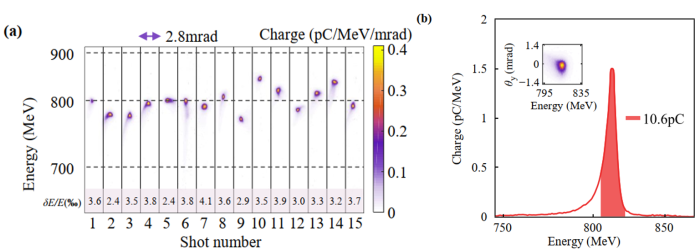Recently, a research team from Shanghai Institute of Optics and Fine Mechanics (SIOM), Chinese Academy of Sciences (CAS), made progress in the generation of few-permille level near-GeV electron beams with laser wakefield accelerator (LWFA) via density-tailored plasma. Such high-quality e beams will boost the development of compact intense coherent radiation sources. This work was published in Physical Review Letters on 25 May, 2021.
The research team manipulates the self-focusing of the laser pulse by tailoring the plasma density. Thus, the degree of the nonlinearity of the wakefield can be controlled which enables a transformation from a highly nonlinear one with a step structure to a less nonlinear one with a sawtooth-like structure. Such a sawtooth-like structure can be used to remove the positive energy chirp of the electron beam.
In the experiments, researchers found that the evolution of the laser pulse and the injection phase of the electron beam can be optimized by adjusting the focal position and the plasma density. This optimization ensures that the electron beam is injected at the end of the density down ramp. Therefore the electron beam slips back to the rear of the bubble during the defocusing of the laser and gets dechirped. Finally, electron beams with a peak energy of near GeV and minimal energy spread of 2.4‰ were obtained with a single-stage gas jet. To the best of our knowledge, the e-beam energy spread is the smallest one obtained from the LWFA.
Aiming at the development of LWFA, the research team has developed the 200-TW ultra-intense and ultra-short laser facility with high focused beam quality and stability [Opt. Laser Technol. 131, 106453, 2020]. Such a facility provides a high-quality driving light source for related physical research.
This work was supported by the National Natural Science Foundation of China, the Strategic Priority Research Program (B), the Youth Innovation Promotion Association, CAS, and the Natural Science Foundation of Shanghai.

FIG. Measured e beams energy spectra. (a) The raw energy spectra of 15 shots with energy spreads ranging from 2.4‰–4.1‰. (b) The spatially integrated energy spectrum of the 13th shot in (a). (Image by SIOM)
Article website:
https://doi.org/10.1103/PhysRevLett.126.214801
Contact:
WU Xiufeng
General Administrative Office
Shanghai Institute of Optics and Fine Mechanics, CAS
Email: xfwu@siom.ac.cn
Web: http://english.siom.cas.cn/